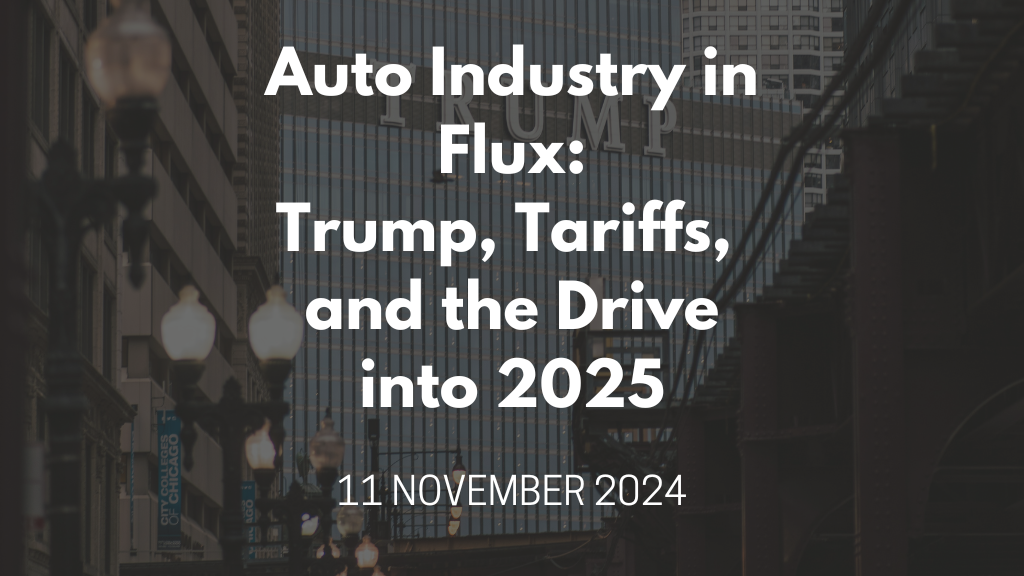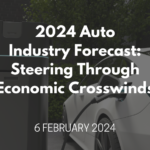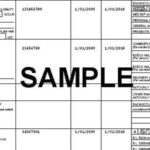Newsflash! If you haven’t heard already, Donald Trump has re-entered the White House! With him behind the presidential wheel once again, automakers can expect a detour that shakes up regulations, trade, and market strategies. As if the current political challenges and economic teeter-tottering aren’t enough, we also have evolving consumer preferences making a sharp turn. let’s dive into what is happening and what could happen to the auto industry as 2024 cruises to a close.
Buckle up and let’s go!
Keypoints:
- If there’s one thing Trump loves, it’s shaking things up, and his presidency promises just that for the auto world. Expect looser environmental regulations, a boon for traditional automakers like Ford and GM.
- Higher tariffs on vehicles and parts imported from places like Mexico and China could mean that automakers reliant on international supply chains will see costs climb faster than a rocket at a space launch.
- Here’s an interesting twist: average transaction prices (ATPs) have dipped slightly compared to last year. Meanwhile, automakers have pulled out the old “discounts and incentives” play to keep buyers interested. Think of it as the industry’s version of a Black Friday sale, only without the trampling.
- The age of the SUV continues! Consumers remain loyal to light trucks, with SUVs and crossovers outselling traditional passenger cars.
Congratulations, Mr. President! (Again)
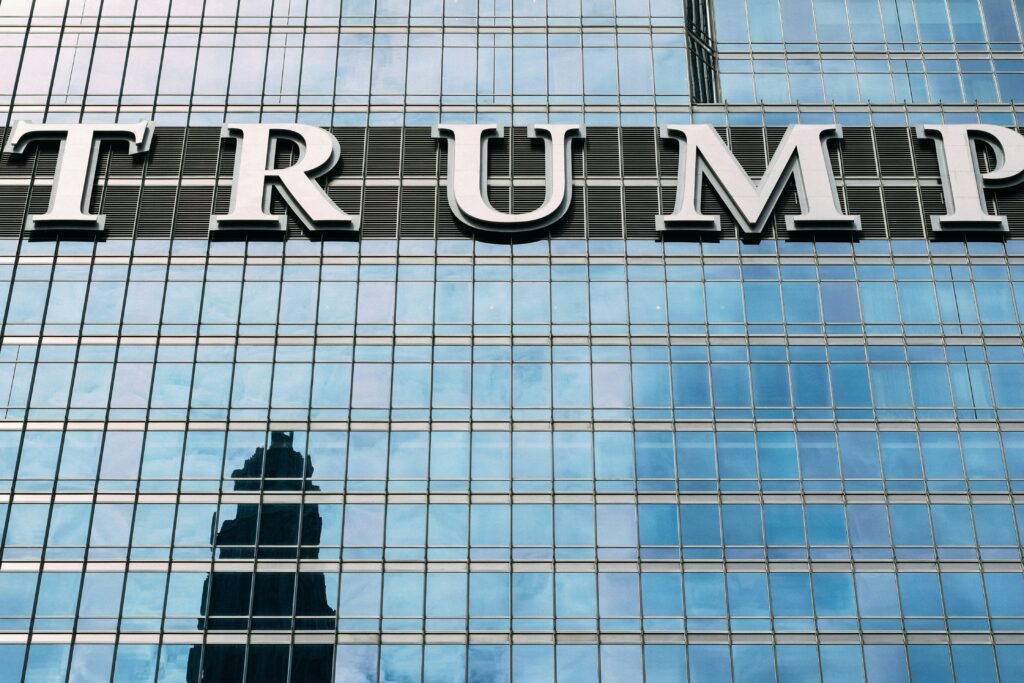
If there’s one thing Trump loves, it’s shaking things up, and his return to the presidency promises just that for the auto world. With looser environmental regulations on the horizon, traditional automakers like Ford and GM are likely celebrating behind closed doors. Fewer emissions rules mean they can keep rolling out their profitable, gas-guzzling trucks without the financial headache of costly overhauls to meet stricter eco-standards.
But for EV makers like Rivian and Lucid, this might feel like trying to sell ice to Eskimos. With less regulatory pressure on emissions, consumers might not feel the urgency to make the switch to electric vehicles. Clean energy? We’ll have to see about that!
And, the plot thickens! Trump’s “America First” mantra isn’t just for show; it comes with real implications. Higher tariffs on vehicles and parts imported from countries like Mexico and China could mean higher costs for automakers relying on international supply chains. Costs might climb faster than a rocket launch, putting pressure on these companies to adapt. However, before we brace for fiery trade wars, keep in mind that Trump’s tough talk often cools down into more moderate policies to avoid major disruptions. Still, the auto industry isn’t holding its breath and is preparing for any curveballs ahead.
? If you’re rooting for EV tax credits and incentives to stick around, Trump’s plans might have you sweating. The potential for scaled-back support could hit electric carmakers where it hurts. However, there’s hope that this won’t turn into an all-out gutting. Automakers and lawmakers know they need to stay competitive, especially with China zooming ahead in the EV race. Fingers crossed for a delicate balance between change and staying in the game. One thing is clear: adaptability will be key. While the industry braces for potential cost surges from trade policies, there's always a chance that Trump's bark might prove louder than his bite.
The Good and the “Could Be Better”
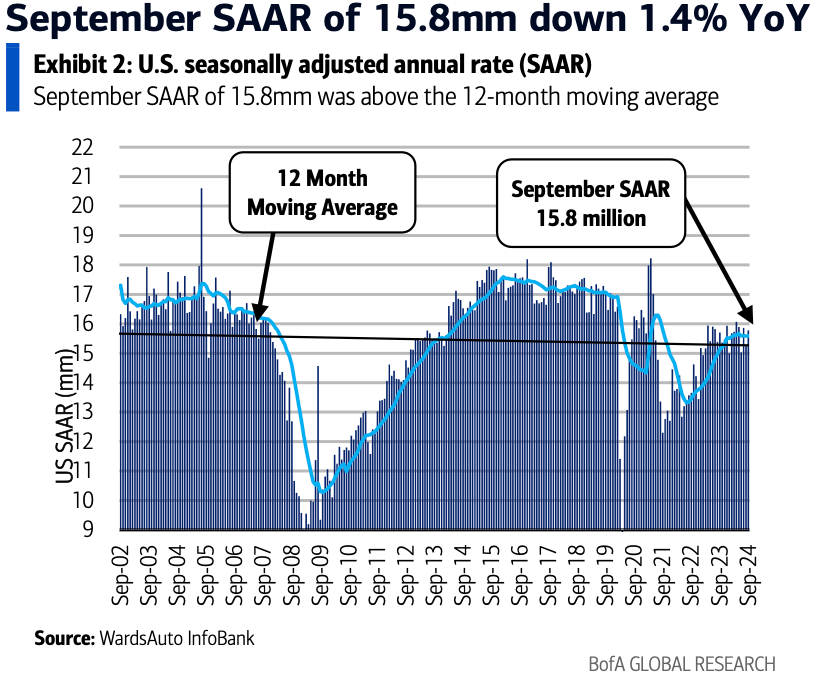
Now on to numbers that show. September didn’t exactly drive off the lot with a bang—vehicle sales took a 1.4% year-over-year dip. But hey, it wasn’t all bad news. Sales bounced back from a sluggish August, clocking an annual rate of 15.8 million units. Analysts are looking to pent-up demand from supply chain woes of yesteryear to keep the market humming along steadily through 2028.
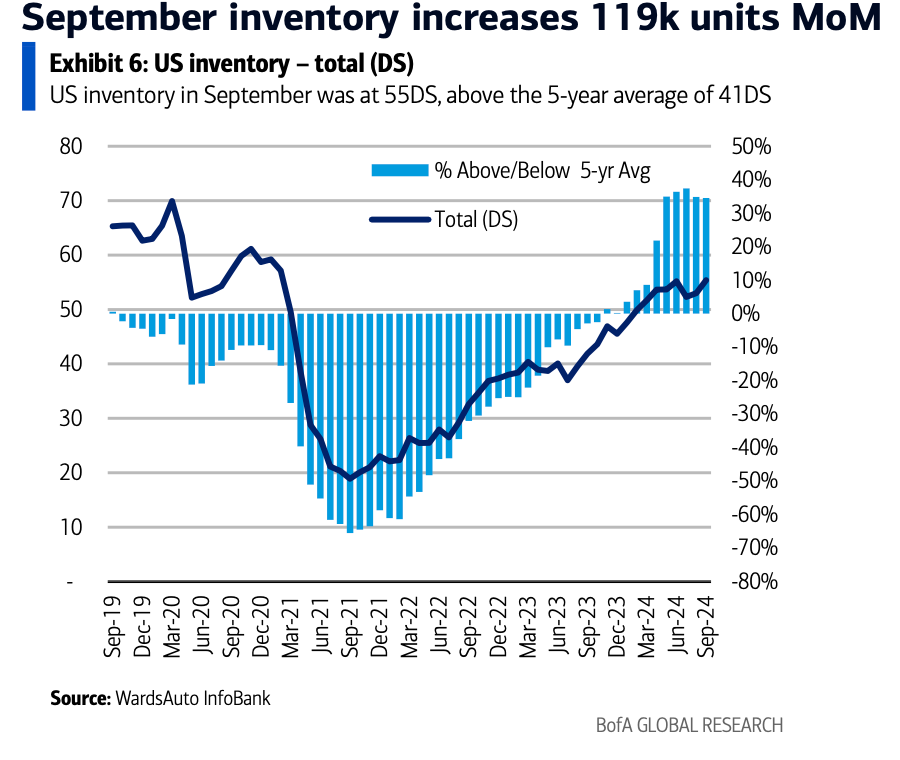
The good news is that for anyone tired of empty dealership lots: inventory levels in September revved up to around 2.82 million units. The “Days Supply” metric, a.k.a. how long current stocks would last if production hit the brakes, is comfortably above the five-year average. It’s not perfect, but it’s definitely progress.
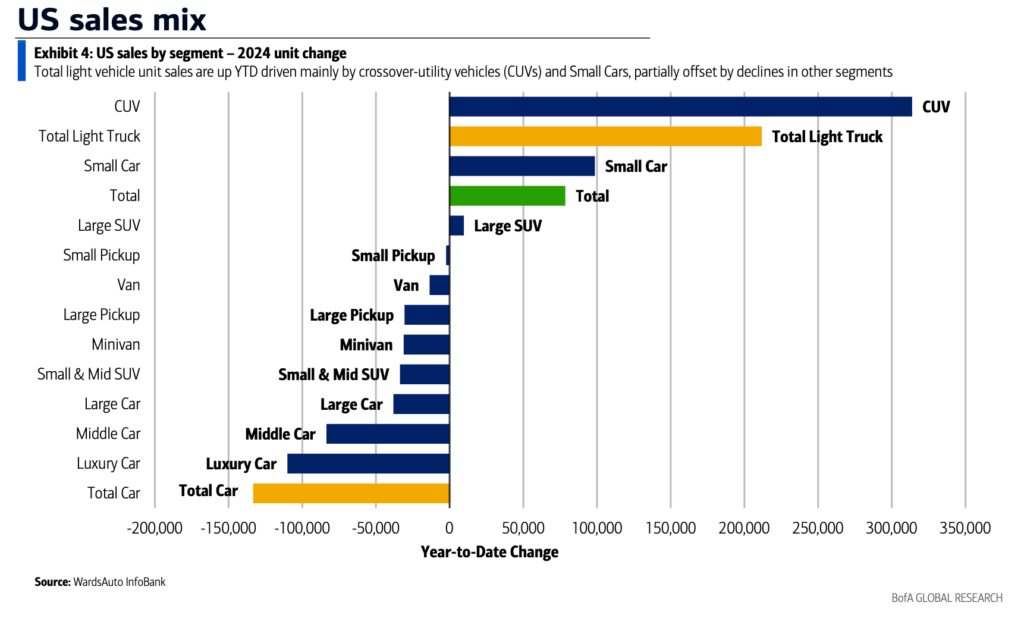
Looks like the age of the SUV continues to reign supreme as consumers show unwavering loyalty to light trucks, with SUVs and crossovers consistently outselling traditional passenger cars. These versatile vehicles are more than just a trend; they have become a lifestyle staple, catering to a generation that values flexibility. Whether it’s for the daily school run, hauling a week’s worth of groceries, or loading up for an impromptu weekend camping adventure, SUVs offer the blend of space, comfort, and performance that buyers crave.
Despite the ups and downs of the current economic landscape, buyers are making calculated decisions. While the appeal of new trucks and flashy SUVs remains strong, there’s a noticeable pause in overall big-ticket spending. The savvy, cost-conscious consumer is treading carefully, striking a balance between immediate desires and the long-term impact on their finances. This means that while interest in SUVs remains high, many buyers are likely shopping with a sharper eye for deals, weighing the benefits of newer models against their price tags, and keeping an eye on potential future rate cuts that might sweeten the deal down the line.
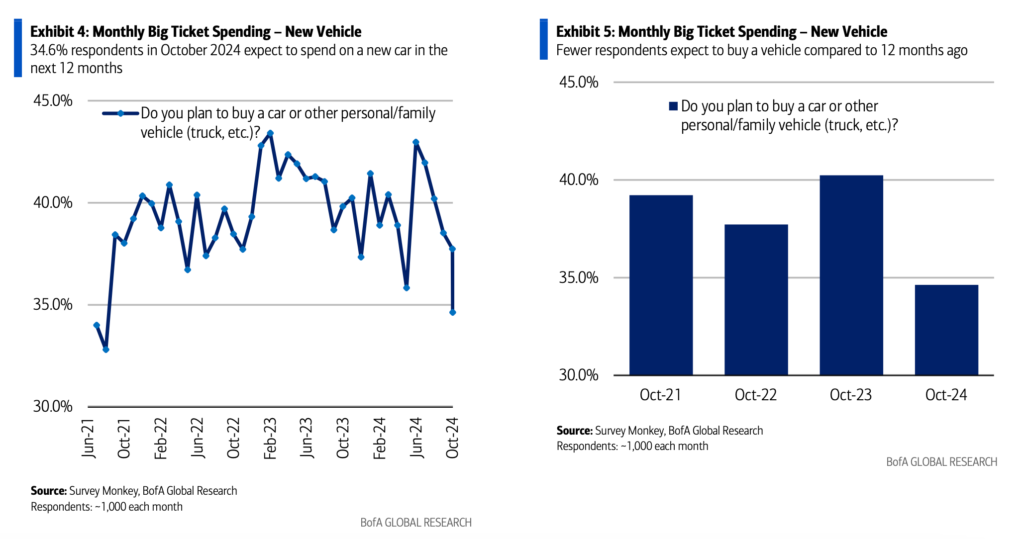
Moving forward, the big question remains: will consumer’s big ticket spending such as car purchases pick up speed? The short-term outlook suggests that a surge in car buying might be on hold for now. High interest rates and economic uncertainty are key factors keeping potential buyers in the parking lot rather than on the road.
But get this, rate cuts are on the horizon, and these could act as a much-needed green light for buyers. Lower rates mean more affordable financing options, which could reignite consumer interest and lead to a boost in vehicle sales. Until then, we’re likely to see cautious spending with consumers waiting for more favorable financial conditions before committing to such significant investments. Patience may be the name of the game as everyone eyes potential rate adjustments and their impact on the broader economy.
?While the current pause in big-ticket spending might feel like a slowdown, it’s important to remember that this is likely just a seasonal dip. The horizon is looking brighter, with rate cuts expected to provide the nudge that buyers need to step back into the market. Once those rate adjustments come through, we can anticipate a renewed wave of consumer confidence and activity. This temporary pause is just that—temporary. Better days are on the way, and the auto industry may be poised for an exciting road ahead.
Price Tags and Bargain Hunters
The age of the SUV continues to reign supreme as consumers show unwavering loyalty to light trucks, with SUVs and crossovers consistently outselling traditional passenger cars. These versatile vehicles are more than just a trend; they have become a lifestyle staple, catering to a generation that values flexibility. Whether it’s for the daily school run, hauling a week’s worth of groceries, or loading up for an impromptu weekend camping adventure, SUVs offer the blend of space, comfort, and performance that buyers crave.
Despite the ups and downs of the current economic landscape, buyers are making calculated decisions. While the appeal of new trucks and flashy SUVs remains strong, there’s a noticeable pause in overall big-ticket spending. The savvy, cost-conscious consumer is treading carefully, striking a balance between immediate desires and the long-term impact on their finances. This means that while interest in SUVs remains high, many buyers are likely shopping with a sharper eye for deals, weighing the benefits of newer models against their price tags, and keeping an eye on potential future rate cuts that might sweeten the deal down the line.
It’s a dance between indulgence and prudence, and consumers are proving that they know how to navigate it. The SUV may symbolize aspiration and readiness for adventure, but today’s buyers are cautious, ensuring they secure the best value while keeping a firm grasp on their wallets. The challenge for automakers lies in meeting this demand without straining consumer trust, as they play the game of incentives and strategic pricing to keep the sales momentum alive.
Here’s an interesting twist to the auto industry saga: average transaction prices (ATPs) have taken a slight dip compared to last year, suggesting a softening in pricing power as economic pressures build. Automakers, clearly not wanting to lose their spot in the consumer’s driveway, have brought back the tried-and-true play of offering discounts and incentives to lure buyers. Think of it as the industry’s version of a Black Friday sale, only without the trampling.
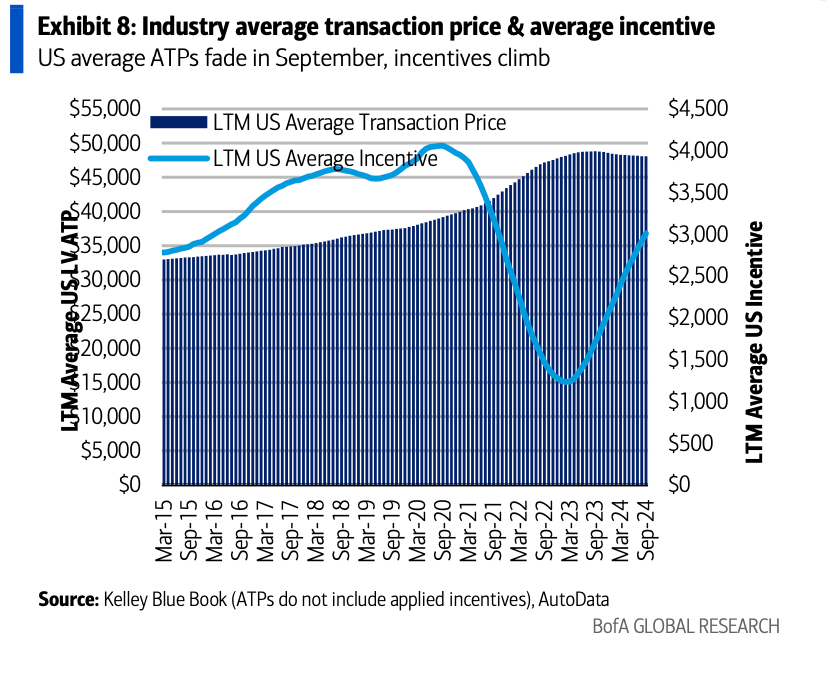
While these incentives are a far cry from their pre-pandemic heyday, they’re an indicator that carmakers are keen to maintain momentum and consumer interest, even if it means trimming profit margins a touch. This strategic move speaks volumes about the industry’s flexibility and awareness of economic sentiment. With inflation still high and buyers watching their budgets closely, these incentives might be just the nudge needed to convince those sitting on the fence to take the plunge.
We do slightly feel that this approach could be a double-edged sword. While it can drive short-term sales, heavy reliance on discounts can train consumers to expect deals, making it challenging to return to normal pricing later. Still, given the current climate, it’s a smart, tactical response to ensure sales stay on track while waiting for broader economic winds, like potential rate cuts, to shift in their favor.
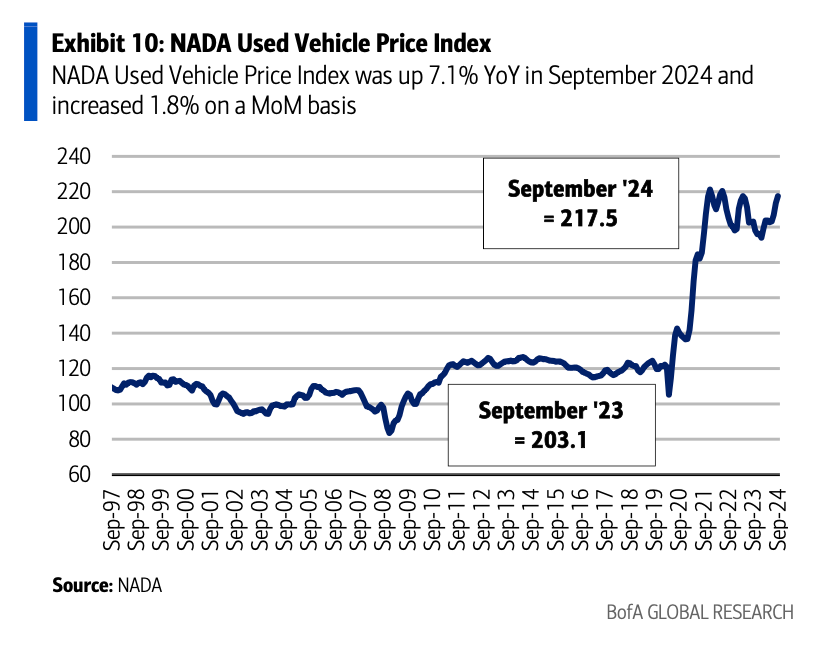
With that being said, the used car market continues to be a bit of a wild ride. If you’ve browsed used car listings lately, you know it’s a mixed bag, to say the least. Prices have been yo-yoing, showing some year-over-year declines, tempered by slight month-over-month increases, signaling that the market is still trying to find its footing. It’s a bit like that indecisive friend who can’t choose between ordering takeout or cooking at home—it’s bound to make up its mind eventually, but not without a few false starts.
This unpredictability in the used car sector runs parallel to trends seen in the new car market, where average transaction prices have softened and manufacturers are leaning on discounts and incentives to keep customers engaged. While automakers are rolling out their version of a “please come back” sale to maintain momentum, the used market isn’t immune to these dynamics. The push-and-pull effect of fluctuating prices and shifting consumer preferences suggests that people are weighing their options, considering whether to spring for a discounted new car or snap up a pre-owned vehicle.
Both markets reflect a broader theme of cautious consumer behavior. People are still making purchases, but they’re being more strategic—shopping around, comparing prices, and waiting for the right deal. The question is, will potential interest rate cuts tip the balance in favor of new cars and bring more stability to the used car market? Until then, we can expect the rollercoaster to continue, with a few more unexpected twists before the ride finally levels out.
?Automakers' use of incentives, even at the cost of slimmer margins, reflects a strategic effort to sustain consumer interest amid economic challenges. While these discounts help attract buyers who might otherwise be deterred by high prices and inflation, they also risk setting a precedent where consumers always expect deals, complicating a return to regular pricing in the future. The market feels like a chess game, with automakers making moves and buyers responding thoughtfully, waiting for potential rate cuts that could open up better financing options. While this might lead to a burst of activity if conditions shift favorably, the strategy carries the risk of creating a market full of deal-seekers. Nonetheless, in today’s economic landscape, maintaining momentum may justify this calculated risk, highlighting the delicate balancing act manufacturers are willing to embrace.
The Road Ahead
With Trump’s return promising a shakeup, the auto industry stands at an intriguing crossroads, filled with both opportunities and uncertainties. Traditional automakers like Ford and GM may find themselves celebrating potential regulatory rollbacks, which could mean fewer restrictions on emissions and fuel standards. This change could allow them to keep their profitable truck and SUV lines running without the financial strain of meeting stricter environmental mandates. It’s a potential windfall for these industry giants, who could channel their resources toward other competitive advantages.
However, it’s not all smooth roads ahead. The flip side of relaxed regulations spells potential trouble for electric vehicle (EV) manufacturers like Rivian, Lucid, and even established players like Tesla. With fewer environmental pressures on consumers to switch to greener options, EV makers could face a more challenging market, where the push for sustainability may slow down, and the competitive edge shifts back to traditional vehicles. Add in Trump’s historically skeptical stance on clean energy incentives and tax credits, and the EV sector could be bracing for leaner years ahead.
But that’s only part of the story. The industry also contends with production slowdowns and supply chain hiccups that have rippled through North American manufacturing. Delayed production schedules have already put a dent in output, forcing automakers to readjust their forecasts and brace for potential dips in profit margins. Even as inventory levels start to stabilize and dealership lots fill up, challenges like trade tariffs and global economic pressures threaten to disrupt this fragile recovery.
On the consumer front, habits are evolving. While interest in big, feature-packed vehicles like SUVs and crossovers remains high, buyers are approaching purchases with caution. High interest rates and economic uncertainties have made big-ticket spending feel more daunting. Although discounts and incentives have re-emerged as key strategies to keep the sales pace steady, automakers walk a fine line—offering enough to entice buyers without conditioning them to always expect a deal.
Amidst all these shifting gears, fluctuating vehicle prices add another layer of complexity. Average transaction prices have dipped slightly, showing that automakers are willing to trim their margins to maintain sales. Meanwhile, the used car market remains a wild card, with prices showing a mix of drops and small month-over-month gains as it stabilizes.
Yet, resilience is a defining trait of the automotive world. From the production line to the showroom, companies are preparing to navigate the twists, turns, and bumps in the road as 2025 rolls into view. With whispers of potential rate cuts and the broader economy finding its footing, the industry might just have the tools to rev up for a more balanced year. Whether it’s adapting to new policies, responding to consumer needs, or managing supply chain challenges, the auto industry is buckled up and ready for whatever comes next.

